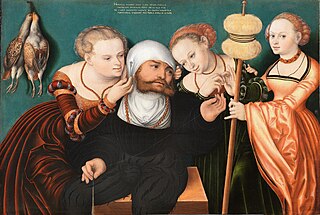Related Research Articles
Andocides was a logographer in Ancient Greece. He was one of the ten Attic orators included in the "Alexandrian Canon" compiled by Aristophanes of Byzantium and Aristarchus of Samothrace in the third century BC.

Gaius Plinius Secundus, called Pliny the Elder, was a Roman author, naturalist, natural philosopher, and naval and army commander of the early Roman Empire, and a friend of the emperor Vespasian. He wrote the encyclopedic Naturalis Historia, which became an editorial model for encyclopedias. He spent most of his spare time studying, writing, and investigating natural and geographic phenomena in the field.

Alcibiades was an Athenian statesman and general. The last of the Alcmaeonidae, he played a major role in the second half of the Peloponnesian War as a strategic advisor, military commander, and politician, but subsequently fell from prominence.
Polygnotus was an ancient Greek painter from the middle of the 5th century BC.

Apelles of Kos was a renowned painter of ancient Greece. Pliny the Elder, to whom much of modern scholars' knowledge of this artist is owed, rated him superior to preceding and subsequent artists. He dated Apelles to the 112th Olympiad, possibly because he had produced a portrait of Alexander the Great.

Aspasia was a metic woman in Classical Athens. Born in Miletus, she moved to Athens and began a relationship with the statesman Pericles, with whom she had a son, Pericles the Younger. According to the traditional historical narrative, she worked as a courtesan and was tried for asebeia (impiety), though modern scholars have questioned the factual basis for either of these claims, which both derive from ancient comedy. Though Aspasia is one of the best-attested women from the Greco-Roman world, and the most important woman in the history of fifth-century Athens, almost nothing is certain about her life.
Nicomachus of Thebes was an ancient Greek painter, a native of Thebes, and a contemporary of the great painters of the Classical period. He trained under his father Aristides, also a painter.

Plutarch's Lives of the Noble Greeks and Romans, commonly called Parallel Lives or Plutarch's Lives, is a series of 48 biographies of famous men, arranged in pairs to illuminate their common moral virtues or failings, probably written at the beginning of the second century AD. The surviving Parallel Lives comprises 23 pairs of biographies, each pair consisting of one Greek and one Roman of similar destiny, such as Alexander the Great and Julius Caesar, or Demosthenes and Cicero. It is a work of considerable importance, not only as a source of information about the individuals described, but also about the times in which they lived.
Agatharchus or Agatharch was a self-taught painter from Samos, who lived in the 5th century BC. His father was named Eudemos (Εὔδημος). He is said by Vitruvius to have invented scenic painting, and to have painted a scene for a tragedy which Aeschylus exhibited. Hence some writers, such as Karl Woermann, have supposed that he introduced perspective and illusionism into painting.
Selymbria, or Selybria (Σηλυβρία), or Selybrie (Σηλυβρίη), was a town of ancient Thrace on the Propontis, 22 Roman miles east from Perinthus, and 44 Roman miles west from Constantinople, near the southern end of the wall built by Anastasius I Dicorus for the protection of his capital. Its site is located at Silivri in European Turkey.
Aegineta was an ancient Greek modeller mentioned by Pliny the Elder. Some scholars supposed that the word Aeginetae in the passage of Pliny denoted merely the country—Aegina—of some artist, whose real name was not given. The consensus of scholarly opinion is now against this hypothesis, however, and it is generally believed that "Aegineta" was the man's given name.
Aglaophon was an ancient Greek painter, born on the island of Thasos. He was the father and instructor of Polygnotus. He had another son named Aristophon. As Polygnotus flourished before the 90th Olympiad, Aglaophon probably lived around the 70th Olympiad, that is, around the late 6th or early 5th century BC. Quintilian praises his paintings, which were distinguished by the simplicity of their coloring, as worthy of admiration on other grounds besides their antiquity.
Antidotus was an ancient Greek painter, mentioned by Pliny the Elder in his Natural History
Arellius was a Roman painter active in the 1st century BC, mentioned by Pliny.

Reyer Jacobsz van Blommendael was a Dutch Golden Age painter from Haarlem.
Bularchus was an Ancient Greek painter; Pliny indicates that he was working in the 8th century BC, during the reign of Candaules, King of Lydia.

Hans Cranach, also known as Johann Lucas Cranach, was a German painter, the oldest son of Lucas Cranach the Elder. German art historian Johann Christian Schuchardt, who discovered his existence, credits him with an altar-piece at Weimar, signed with the monogram "H. C.", and dated 1537. He died at Bologna in 1537. Luther mentions his death in his Table Talk, and Johann Stigel, a contemporary poet, celebrates him as a painter.
Cydias, a native of Cythnus, who was living in 364 BC, may be presumed to have been a painter of considerable ability, as one of his pictures, representing Jason and his followers embarking for Colchis, in search of the Golden Fleece, was purchased at Rome by the orator Hortensius for 144,000 sesterces. Afterwards the work was bought by Marcus Agrippa and placed in the Porticus of Neptune to commemorate his naval victories.
Mnasitheus or Mnesitheus of Sicyon was an ancient Greek painter of some fame mentioned by Pliny the Elder in his Natural History.
Aristophon was native of the deme of Collytus, a great orator and politician, whose career is for the most part contemporaneous with that of Demosthenes. It was this Aristophon whom Aeschines served as a clerk, and in whose service he was trained for his public career.
References
- ↑ Bryan 1886.
- ↑ Verdegem 2010, p. 219.
- ↑ Verdegem 2010, p. 222.